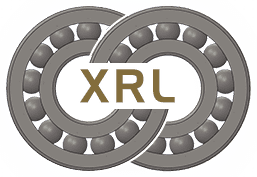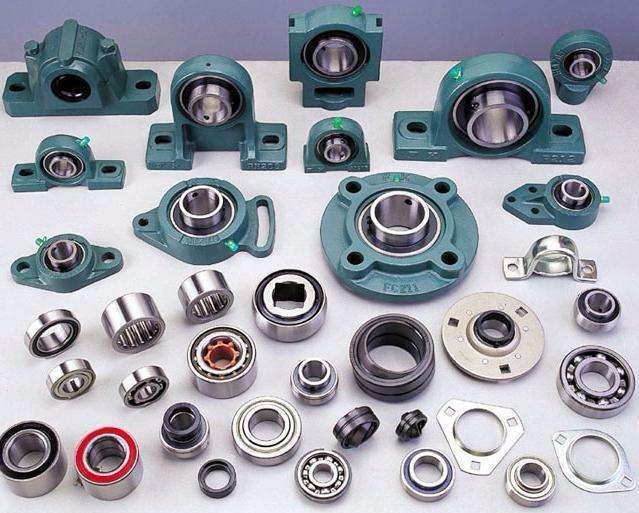1 When the bearing is installed, the inner diameter of the bearing and the shaft, the outer diameter and the housing are very important. When the fit is too loose, the mating surface will slide relative to each other, which is called creep. Once creep occurs, it will wear the mating surface, damage the shaft or the shell, and the wear powder will invade the inside of the bearing, causing heat, vibration and damage. When the interference is too large, the outer diameter of the outer ring will become smaller or the inner diameter of the inner ring will become larger, which will reduce the internal clearance of the bearing. In addition, the geometric accuracy of the shaft and shell processing will also affect the original accuracy of the bearing ring, thus affect the performance of the bearing.
1.1 Choice of fit 1.1.1 The nature of the load and the choice of fit depends on the direction in which the bearing bears the load and the rotation conditions of the inner and outer rings, generally refer to Table 1. Table 1 The nature of the combined load and the rotation conditions of the matching bearing Legend Load nature Fitting method Inner ring: rotating Negative ring: Static load direction: Fixed Inner ring Rotating load Outer ring Static load Inner ring: Static fit (interference fit) Outer ring: Dynamic fit (clearance fit) available Inner ring: Static Negative ring: Rotating load direction: Rotating simultaneously with the outer ring Inner ring: Rotating Negative ring: Static load direction: Fixed inner ring Static load Outer ring rotating load Inner ring: Dynamic fit available (Clear fit) Outer ring: Static fit (interference fit) Inner ring: Static Negative ring: Rotating Load direction: Simultaneous rotation with the inner ring. 2) Recommended fit In order to select a fit suitable for the purpose, the nature, size, temperature conditions of the bearing load, and various conditions for the installation and disassembly of the bearing should be considered. When the bearing is mounted on a thin-walled shell or a hollow shaft, the interference needs to be larger than ordinary; the separate shell is easy to deform the outer ring of the bearing, so it should be used with caution when the outer ring needs to be statically fitted; in the case of large vibration, The inner and outer rings should adopt static fit.
For the most general recommended fit, refer to Table 2, Table 3 Table 2 Applicable conditions for radial bearings and shafts (for reference) Shaft diameter (mm) Remarks for spherical roller bearings Ball bearings Cylindrical roller bearings Tapered roller bearings Automatic adjustment Central roller bearings Cylindrical bore bearings and the outer ring of the shaft The rotating load needs the inner ring to be easy to move on the shaft All dimensions of the wheels of the stationary shaft g6 When the accuracy is required, use g5, h5, large bearings and requirements for easy movement can also be used instead of h6 The inner ring needs to be easy to move on the shaft Tensioner frame, sheave h6 The inner ring rotates or the direction is indefinite. The light load is below 0.06Cr(1). — — Js5 When the accuracy is required, use p5 class, and use h5 for precision ball bearings with an inner diameter of 18mm or less. 0.13) The load of Cr (1) in the general bearing part is below 18 for large electric motors, turbines, pumps, engine shafts, gear transmissions, and woodworking machinery — n6 single-row tapered roller bearings and single-row radial thrust ball bearings can be replaced by k6 and m6 k5, m5. 18-100 below 40 p6 140-200 40-100 40-65 r6 200-280 100-140 65-100 r7— 140-200 100-140 n6— 200-400 140-280 p6— — 280-500 r6——over 500 r7 heavy load (more than 0.13Cr(1)) load or impact load railway, industrial vehicle tram main motor construction machinery pulverizer—50-140 50-100 n6 bearings that require greater than normal clearance — 140-200 100-140 p6 — more than 200 140-200 r6 — — 200-500 r7 Only bear axial load All bearing parts of various structures All dimensions Js6 (j6) — Table 3 Radial bearing and housing hole Applicable examples of matching conditions (reference) Housing hole tolerance class Movement of the outer ring Remarks Integral housing hole Outer ring Rotating load Wall bearing Heavy load Automobile wheels (roller bearings) Crane running wheels P7 The outer ring cannot move in the axial direction.
Ordinary load, heavy load automobile wheel (ball bearing) vibrating screen N7 light load or variable load conveyor pulley, pulley tensioner M7 non-directional load large impact load main engine of tram ordinary load or light load pump crankshaft medium and large motor K7 outside In principle, the outer ring cannot move in the axial direction. The outer ring does not need to move in the axial direction. The integral housing hole or the separate housing hole is normal load or light load JS7 (J7). The outer ring can move axially. The outer ring can move axially. Directional movement Inner ring rotational load All kinds of loads General bearings Part of the bearing housing of railway vehicle H7 The outer ring moves in the axial direction easily – common load or light load bearing with seat H8 Integral shell shaft and inner ring become high temperature paper dryer G7 ordinary load, light load, especially need precision rotary grinding spindle rear ball bearing high-speed centrifugal compressor fixed side bearing JS6 (J6) outer ring can move in the axial direction – non-directional load grinding spindle rear ball bearing high speed Centrifugal compressor fixed side bearing K6 When the outer ring is fixed in the axial direction in principle, an interference fit larger than K is applicable. In the case of special requirements for high precision, it is necessary to further use a small allowable difference according to the application. Cooperate.
The rotating load of the inner ring changes the load, especially requiring precise rotation and high rigidity. Cylindrical roller bearings for machine tool spindles M6 or N6. The outer ring is fixed in the axial direction and requires noiseless operation. Household appliances H6. The outer ring moves in the axial direction—3), shaft 1. If the precision of the shell and the surface roughness of the shaft and the shell are not good enough, the bearing will be affected by it and cannot perform the required performance. For example, if the accuracy of the installation part of the shoulder is not good, the inner and outer rings will be inclined. In addition to the bearing load, the concentrated load at the end will reduce the fatigue life of the bearing, and more seriously, it will cause damage to the cage and sintering. Furthermore, the deformation of the housing due to external loads is small. It is necessary to be able to fully support the rigidity of the bearing. The higher the rigidity, the more beneficial it is to the bearing noise and load distribution.
Under normal conditions of use, turning finishing or precision boring machine processing is sufficient. However, for occasions with strict requirements on rotation runout and noise and load conditions that are too harsh, grinding finishing is required. When more than 2 bearings are arranged in the overall shell, the mating surface of the shell should be designed to be able to process the perforation. Under normal conditions of use, the accuracy and smoothness of the shaft and housing can be based on Table 4 below. Table 4 Accuracy and smoothness of the shaft and housing Item bearing grades Shaft housing roundness tolerance 0, 6, 5, 4 IT3 ~ IT42 2IT3 ~ IT42 2 IT4 ~ IT52 2IT3 ~ IT42 2 Cylindricity tolerance 0, 6 Grade 5, Grade 4 IT3 ~ IT42 2IT2 ~ IT32 2 IT4 ~ IT52 2IT2 ~ IT32 2 Shoulder run-out tolerance Grade 0, Grade 6 Grade 5, Grade 4 IT3IT3 IT3~IT4IT3 Fitting surface finish Rmax Small bearings Large bearings 3.2S6.3S 6.3S12.5S.
2 Bearing clearance: Bearing clearance is shown in Figure 1: Figure 1 Bearing clearance 2.1 Bearing internal clearance The so-called bearing internal clearance refers to the part of the inner ring or outer ring of the bearing when it is not installed on the shaft or bearing box. Fix it, and then make the unfixed side move radially or axially. According to the direction of movement, it can be divided into radial clearance and axial clearance. When measuring the internal clearance of a bearing, in order to stabilize the measured value, a test load is generally applied to the ring. Therefore, the test value is larger than the actual clearance value, that is, there is one more amount of elastic deformation caused by applying the test load. The actual value of the internal clearance of the bearing is according to Table 4.5. The increase in clearance caused by the above elastic deformation is corrected. The amount of elastic deformation of roller bearings is negligible. Table 4.5 is the radial clearance correction to eliminate the influence of the test load (deep groove ball bearing) Unit: um Nominal bearing model inner diameter d (mm) Test load (N) Clearance correction exceeds C2 Ordinary C3 C4 C510 (included) 18 24.549 147 3~4 4~5 6~8 45 8 4 6 9 4 6 9 4 6 92.2 Selection of bearing clearance The running clearance of the bearing is generally larger than the initial clearance due to the bearing fit and the temperature difference between the inner and outer rings. Small. The running clearance is closely related to the life of the bearing, temperature rise, vibration and noise, so it must be set to the optimum state.
Theoretically speaking, when the bearing is in operation, with a slightly negative running clearance, the life of the bearing is the largest. But it is very difficult to maintain this optimal clearance. As the service conditions change, the negative clearance of the bearing will increase accordingly, resulting in a significant decrease in the bearing life or heat generation. Therefore, the initial clearance of the bearing is generally set to be slightly greater than zero. Figure 2: Changes in radial clearance of bearings 2.3 Selection criteria for bearing clearance Theoretically speaking, when the bearing is in a safe operating state and has a slightly negative operating clearance, the bearing life is the largest. But in fact, it is very difficult to maintain this optimal state. Once a certain use condition changes, the negative clearance will increase, which will lead to a significant decrease in bearing life or heat generation. Therefore, when selecting the initial clearance, it is required that the running clearance be only slightly greater than zero.
For bearings used under normal conditions, the normal load fit will be used. When the speed and temperature are normal, only the corresponding normal clearance should be selected to obtain a suitable running clearance. Table 6 Applicable examples of very common clearance Use conditions Applicable occasions Select clearance to bear heavy loads, impact loads, and large interference Axle C3 Vibrating screens C3 and C4 bear non-directional loads, and both inner and outer rings adopt static fit railway vehicle traction Motor C4 tractor, final reducer C4 bearing or inner ring heating paper machine, dryer C3, C4 rolling mill roller roller C3 reduce rotation vibration and noise micro motor C2 adjust clearance and control shaft vibration NTN machine tool spindle (double row cylinder Roller bearings) C9NA, C0NA.
Post time: Feb-23-2023

